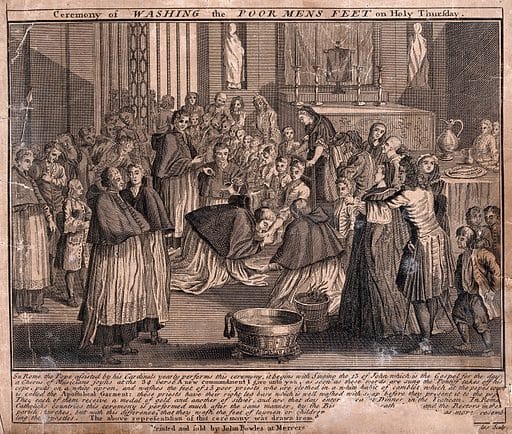
Welcome to our comprehensive guide to Maundy Thursday, a significant day in Holy Week observances. In this article, we will explore the profound meaning behind Maundy Thursday and delve into the rich tapestry of traditions and customs associated with this important religious day.
Key Takeaways:
- Maundy Thursday is a pivotal day in Holy Week, commemorating the Last Supper and the events leading up to Jesus’ crucifixion.
- The term “Maundy” is derived from the Latin word “mandatum,” meaning commandment, referencing Jesus’ commandment to love and serve one another.
- Maundy Thursday is marked by symbolic practices such as the washing of feet, in remembrance of Jesus washing the feet of his disciples.
- Another significant tradition of Maundy Thursday is the commemoration of the Last Supper, where Christians partake in the sacrament of the Eucharist.
- Many churches also hold special Maundy Thursday services, including the ceremony of the washing of feet and the adoration of the Blessed Sacrament.
Understanding the Meaning and History of Maundy Thursday
Maundy Thursday, also known as Holy Thursday, is an important day in the Christian calendar. It falls on the Thursday before Easter Sunday and holds deep religious significance for believers worldwide. To fully appreciate the traditions and observances associated with Maundy Thursday, it is essential to understand its meaning and historical roots.
The Meaning of Maundy Thursday
Maundy Thursday derives its name from the Latin word “mandatum,” meaning “commandment.” This name refers to the biblical account in the New Testament, where Jesus Christ shared the Last Supper with his disciples and gave them a new commandment:
“A new commandment I give to you, that you love one another: just as I have loved you, you also are to love one another.” – John 13:34
This commandment, related to the act of foot washing performed by Jesus during the Last Supper, is central to the meaning of Maundy Thursday. It serves as a powerful reminder for believers to love and serve one another, following the example set by Jesus.
The History of Maundy Thursday
The historical origins of Maundy Thursday can be traced back to the early Christian church. It is closely associated with the Jewish festival of Passover, as the Last Supper shared by Jesus and his disciples was a Passover meal. The events of Maundy Thursday, including the washing of feet and the institution of the Eucharist, are described in the Gospels of Matthew, Mark, and Luke.
Over the centuries, Maundy Thursday has evolved into a day of special significance and observance within Christianity. It marks the beginning of the Easter Triduum, the three-day period that commemorates the passion, death, and resurrection of Jesus Christ.
Key Events of Maundy Thursday
| Event | Description |
|---|---|
| The Last Supper | Jesus shared a final meal known as the Last Supper with his disciples, during which he instituted the sacrament of the Eucharist. |
| Foot Washing | Jesus humbly washed the feet of his disciples, demonstrating the importance of service and humility. |
| Agony in the Garden | After the Last Supper, Jesus went to the Garden of Gethsemane to pray, where he experienced deep anguish and was arrested by Roman soldiers. |
| Betrayal by Judas | Judas Iscariot, one of Jesus’ disciples, betrayed him to the religious authorities, leading to his arrest. |
Traditions and Customs of Maundy Thursday
Maundy Thursday is steeped in rich traditions and customs that hold significant meaning for Christians around the world. This sacred day, which falls during Holy Week, is observed with reverence and devotion, commemorating the events leading up to Jesus Christ’s crucifixion and resurrection.
Symbolic Washing of Feet
One of the central traditions observed on Maundy Thursday is the symbolic washing of feet. This act of humility and service is inspired by Jesus Christ’s example of washing the feet of his disciples during the Last Supper. In churches and religious communities, individuals may gather to reenact this powerful gesture, demonstrating love, service, and compassion towards one another.
Commemoration of the Last Supper
Maundy Thursday also marks the commemoration of the Last Supper, the final meal shared by Jesus Christ with his disciples before his crucifixion. This event holds great significance as it is believed to be the institution of the Holy Eucharist, where Jesus established the practice of sharing bread and wine in remembrance of his sacrifice. In churches worldwide, believers come together to participate in Communion or Mass, honoring this sacred moment in Christianity.
Other Significant Practices
In addition to foot washing and the commemoration of the Last Supper, Maundy Thursday is associated with various other significant practices and customs. These may include:
- Attending special church services or liturgies that focus on the events of Holy Week.
- Participating in prayer vigils or extended periods of prayer and reflection.
- Adorning churches and altars with Maundy Thursday flowers and decorations.
- Observing the tradition of fasting or abstaining from meat as a form of penance and spiritual preparation.
These customs and practices help believers connect with the solemnity of Maundy Thursday and immerse themselves in the spiritual journey of Holy Week.
Maundy Thursday Services and Church Observances
Maundy Thursday, also known as Holy Thursday, is a significant day in the Christian calendar that commemorates the Last Supper of Jesus Christ with his disciples. On this solemn occasion, believers gather in churches around the world to participate in various religious services and observe ancient customs that have been passed down through generations.
One of the primary rituals carried out during Maundy Thursday services is the symbolic washing of feet, which represents humility and service. This act is derived from Jesus’ act of washing the feet of his disciples as a demonstration of love and servanthood. By engaging in this act, believers seek to emulate Christ’s example and demonstrate love and compassion towards others.
Another central element of Maundy Thursday services is the commemoration of the Last Supper, where Christ instituted the sacrament of Holy Communion. This sacred ritual involves the sharing of bread and wine, symbolizing the body and blood of Jesus, respectively. Through participation in Holy Communion, believers express their faith, remember Christ’s sacrifice, and seek spiritual nourishment.
“Do this in remembrance of me.”
– Jesus Christ
Alongside the washing of feet and the sharing of Holy Communion, churches often incorporate other practices into their Maundy Thursday services. These may include the reading of relevant scriptures, periods of solemn reflection and prayer, hymn singing, and the ringing of church bells to mark the beginning and end of the service.
Overall, Maundy Thursday services and church observances provide Christians with an opportunity to reflect on the significance of Christ’s sacrifice, to deepen their faith, and to enter into the contemplative spirit of Holy Week. These services offer believers a time of spiritual renewal and serve as a meaningful prelude to Good Friday and Easter Sunday.
| Key Elements of Maundy Thursday Services: |
|---|
| Symbolic washing of feet |
| Commemoration of the Last Supper |
| Participation in Holy Communion |
| Reading of relevant scriptures |
| Periods of solemn reflection and prayer |
| Hymn singing |
| Ringing of church bells |
Conclusion
In conclusion, Maundy Thursday holds deep meaning for Christians around the world. This significant day in Holy Week is marked by a rich tapestry of traditions and observances that provide believers with a profound spiritual journey.
By understanding the significance of Maundy Thursday and actively engaging in the practices associated with it, believers can fully appreciate the essence of Holy Week. Through symbolic acts such as the washing of feet and the commemoration of the Last Supper, Christians honor the selfless love and sacrifice exemplified by Jesus Christ.
Maundy Thursday services and church observances allow believers to come together in worship and reflection, creating a sacred atmosphere filled with reverence and spiritual connection. This collective participation strengthens the sense of community and unity among Christians, as they join in solidarity to remember the events leading up to the crucifixion of Jesus.
By embracing these traditions and observing Maundy Thursday with devotion and reverence, Christians enhance their understanding of their faith and deepen their spirituality. Through this, they are able to experience the profound significance of Maundy Thursday, enhance their relationship with God, and find inspiration for living a life of love and service to others throughout the entire year.
FAQ
What is the significance of Maundy Thursday?
Maundy Thursday commemorates the Last Supper of Jesus Christ with his disciples, where he instituted the sacrament of Holy Communion. It holds deep meaning for Christians as it marks the beginning of the Easter Triduum, symbolizing the sacrifice and love of Jesus.
What is the history behind Maundy Thursday?
Maundy Thursday derives its name from the Latin word “mandatum,” meaning commandment. It refers to the commandment that Jesus gave to his disciples during the Last Supper to love one another. The observance of Maundy Thursday dates back to the early days of Christianity.
What are some traditions associated with Maundy Thursday?
One of the most notable traditions of Maundy Thursday is the ceremonial washing of feet, which symbolizes humility and service. Another custom is the distribution of Maundy money by various monarchs to the elderly. Many Christians also participate in Holy Communion and attend church services on this day.
Are there special church services held on Maundy Thursday?
Yes, Maundy Thursday is marked with special church services. These services often include the reenactment of the Last Supper, the washing of feet by clergy or members of the congregation, and the celebration of Holy Communion. Some churches also hold prayer vigils or observe the Stations of the Cross.
How is Maundy Thursday observed in the year 2024?
The specific observances and services for Maundy Thursday in 2024 will vary based on individual churches and denominations. It is best to consult with your local church or religious authority for information on the specific activities and services planned for Maundy Thursday in 2024.
